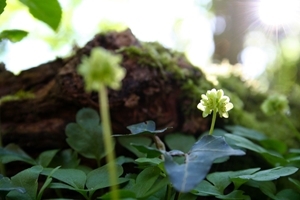Moschatel
 It is no secret that spring is my most favourite time of year. I will never tire of seeing woodlands flush with flowers like it has been woken from a long sleep, noticing the change in the bird song, and starting the annual family competition to see who can spot the first signs of spring, which I have been doing with my mother for as long as I can remember.
It is no secret that spring is my most favourite time of year. I will never tire of seeing woodlands flush with flowers like it has been woken from a long sleep, noticing the change in the bird song, and starting the annual family competition to see who can spot the first signs of spring, which I have been doing with my mother for as long as I can remember.
My species of the month is an unusual, small, unassuming plant in a family of its own, that is often missed if you don’t look hard enough, but when you do notice it, you will admire its beauty year on year and hunt it out like I do: moschatel (Adoxa moschatellina). The name moschatel is a reference to the flower’s musk-like scent that is most noticeable in the evening.
Moschatel is especially common in ancient woodland and is an ancient woodland indicator species here in the south, which means it’s a species that gives us a clue that the woodland is ancient due to the slow colonisation character of some plants, e.g. bluebell, wood anemone, wood sorrel. But be warned: some plants are ancient woodland indicators in one region and not in others! Ancient woodlands are complex, rich, irreplaceable ecosystems that have been around long enough to develop over time. In the UK, our ancient woodlands are sites that have been continuously wooded since medieval times, with a threshold date of 1600 AD (1750 AD in Scotland). This date is when reliable maps started to become widely produced. But it also pre-dates the time when tree-planting became common.
Having developed over such long timescales, ancient woodlands have many unique features, plant communities and animals, which depend on the stable, undisturbed conditions that ancient woodland provides. Ancient woodlands are also living history books, with features such as medieval boundary banks, charcoal hearths and old coppice stools hinting at human activity in centuries past.
Moschatel is alternatively called townhall clock, which is a reference to the way that the flowers are arranged. It has four flowers at right angles to each other, much like a clock face, and a fifth flower on top facing skyward, giving the appearance of a little cube of flowers atop a single stem. The flowering stem stands around 5-12cm tall, with creeping scaly rhizomes below. The four flowers each have five petals and the flower on top has four. The styles and stamen of each flower match the petal count. The leaves appear in opposite pairs and are fleshy, pale green. The leaf stalks flatten where they join the stem and each leaf is split into three-lobed leaflets and tipped with a fine tiny spine.
So where can you see this lovely little plant? It is extremely common in most of England, Wales and Scotland except for the far north and northeast but is almost totally absent from Ireland.
I have found the best way to find this plant is to look for the three-lobed, light green leaves in February or March and watch out for the townhall clock flowers standing tall in April. So, look out for this unusual flower by streams and in woods, along woodland tracks and rides, and in damp hedgerows, while you are out getting some vitamin D, working hard or out with the dog. Once you’ve seen it once, I am sure you will keep an eye out for this little springtime beauty in the future, year on year.
Hooray for SPRING!
Megan Lock
Advisory